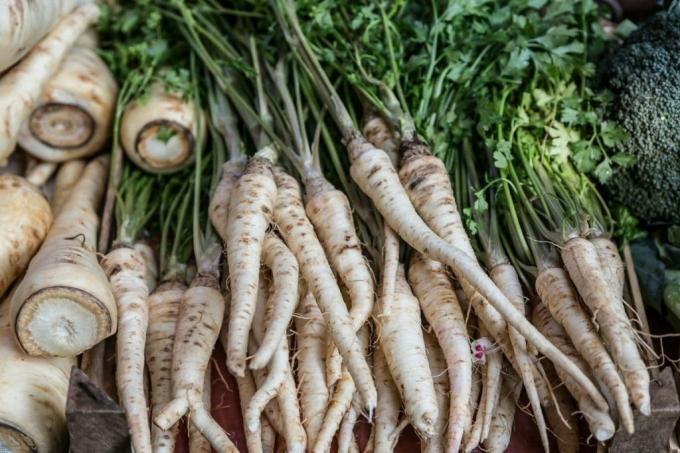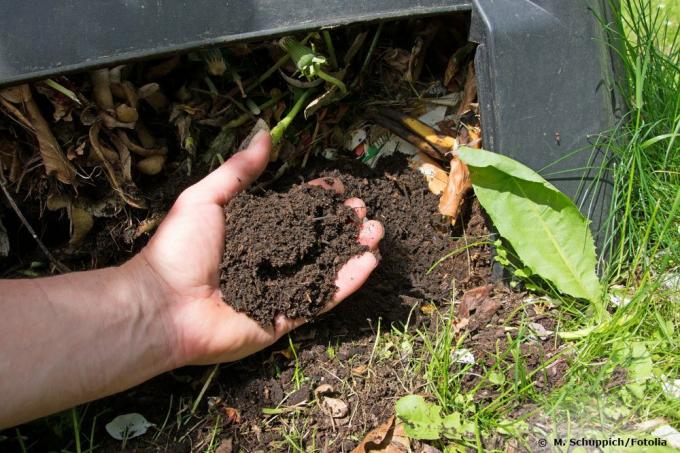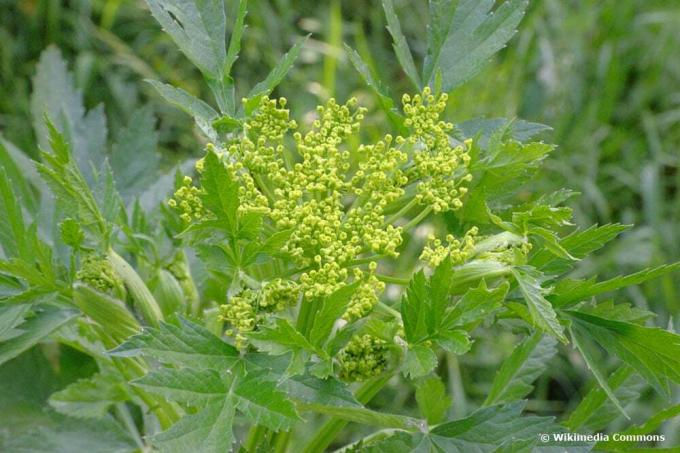
table of contents
- The vegetable
- Location
- sowing
- care
- To harvest
- To store
- Diseases and pests
- Suitable varieties
- Multiplication
- frequently asked Questions
The parsnip was almost forgotten. Today it is popular with housewives and celebrity chefs alike. That root vegetable is versatile, tasty and healthy. How do you grow yourself in the garden?
In a nutshell
- traditional root vegetables
- suitable for self-cultivation
- hardy, resistant to diseases
- Taste nutty, spicy, slightly sweet
- suitable for soups, purees, salads and more
The vegetable
Parsnips had almost been forgotten. Today they made it back into cookbooks and restaurant menus. The white to yellowish thick roots can be used in many ways. They combine a multitude of positive properties, are rich in minerals and healthy, easy to grow, easy to store and disease-resistant. With their pleasantly spicy, slightly nutty taste, parsnips are perfect for preparing stews, soups, purees and salads.
The parsnip belongs to the umbelliferae family (Apiaceae). It consists of a pointed, white-yellowish root with a thick head and herbaceous leaves. By the way, the parsnip is also known as mutton carrot or bog root. The vegetables are easy to care for and robust. Do you want to grow parsnip roots in your own garden? We show you what to look out for.

Location
If you want to grow the root vegetables in the garden, choose a sunny to partially shaded location.
For parsnips to be grown successfully, the soil must be
- relaxed
- wet
- profound
- be nutritious.
The substrate can be sandy or contain a small amount of clay. Heavy, compacted soil impairs the development of the root vegetables. Only round, short varieties such as - White King - Kral Russian thrive on heavy soil. Before planting, loosen the soil thoroughly and mix in some compost. Avoid adding horse manure. This attracts the carrot fly and changes the taste of the parsnips.
sowing
Sow parsnip seeds two centimeters deep into the prepared, well-loosened bed between the beginning of April and the end of May. The root vegetables germinate very slowly. In order not to lose sight of the plants, marking seeds with fast germinating plants are recommended. Radishes or lettuce are suitable as marking seeds. Regularly chop the soil between the rows and keep the bed weed-free.
The seeds germinate after 20 days. When the young plants show up, they can be separated at a distance of 15 to 20 centimeters. The distances are necessary because parsnips develop more foliage than carrots.

Tip: In cold regions, you should prefer the parsnip plants in seed trays on the windowsill. After the ice saints, plant the young plants in the prepared bed.
Plant neighbors
Experienced gardeners know that the development of parsnips can be positively or negatively influenced by plants in the immediate vicinity.
Suitable neighbors:
- radish
- radish
- salad
- peas
- beetroot
- Onions
- Marigolds
Unsuitable neighbors:
- parsley
- fennel
- celery
care
Fertilize
Adding compost to the preparation of the parsnip patch is sufficient for the root vegetables to develop properly. Additional fertilizers are not required.

to water
Watering the plants is particularly important in the summer months and when it is dry. Parsnips that stand too dry will only develop short roots. Regularly loosen the soil. Prevent waterlogging.
To harvest
At the end of October the white roots are ready to be harvested. It is worth leaving the vegetables in the bed until after the first frost. The cold allows the aroma to develop even better. The tasty roots can be harvested well into winter. Carefully loosen the soil with a digging fork to remove the parsnips without damage.
Note: As with carrots, parsnip leaves can cause skin irritation in sensitive people. Protect yourself with gloves when harvesting.
To store
The best way to store the root vegetables is in a frost-free cellar.
Fill buckets with damp sand. Tuck the roots all the way in. Make sure that the sand does not dry out. Drought makes the parsnips tough. Alternatively, the root vegetables can be stored in the refrigerator or on the balcony. Wrap the roots in a damp linen cloth.

Diseases and pests
The parsnip is uncomplicated and resistant to diseases and pests. The soft rot caused by bacteria occurs rarely. Well-loosened, weed-free soil offers the best protection against this disease, which also affects carrots. Just like carrots, celery and parsley, parsnips can also be attacked by the carrot fly. Protect your plants with vegetable fly nets. The mixed culture with onions, garlic and chives prevents infestation with carrot flies.
Suitable varieties
Due to the increasing popularity of the white roots, interested parties can now find a large selection of old and new types of parsnip in stores. These varieties are suitable for growing in your own garden:
White King
- excellently suited for raw consumption
- pleasant consistency
Half-length whites
- very cute
- suitable for baby food
- Aromata - nutty, sweet
- delicate, light yellow roots
Turga
- very frost hardy
- long roots
Kral Russian
- short, rounded roots
- pleasantly sweet
Multiplication

The parsnip is a biennial plant. After harvesting, leave two to three parsnip roots in the ground. They will produce flowers in the coming year. The flowers look beautiful and magically attract bees. The seeds are easy to harvest. Keep the parsnip seeds dry and dark. They do not have a long shelf life and have to be applied in the following year.
frequently asked Questions
Heavy, dense soil leads to the formation of short, thin, multi-legged roots. Before growing, loosen the soil thoroughly and add compost. Let the bed rest for a week before ordering. We recommend green manuring with phacelia or lupins for optimal preparation of the bed.
The yellowing of the leaves is often caused by a lack of magnesium. A location that is too shady or waterlogged can also lead to discoloration of the leaves.
The healthy vegetables are suitable for raw consumption. Remove the leaves and peel and clean the roots with clean water. Enjoy the parsnip like a fresh carrot or prepare a tasty salad from it.
